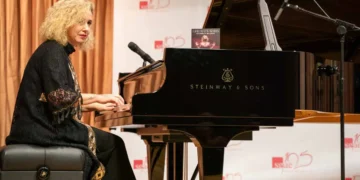Original Spanish text by Augusto García Flores, translated with his permission for Deflamenco
For decades, Mariquita Flores (La Línea de la Concepción, 1916-USA, 2015), was the grande dame of Spanish dance instructors in the United States.
Her knowledge and dedication during a long lifetime inspired several generations of dancers. Mariquita passed away the evening of Thursday, April 30, just 33 days short of her 99th birthday. She will be remembered by many as one of the pioneers of Spanish, flamenco, escuela bolera and regional dance in the United States.
Augusto García Flores, Mariquita's nephew, wrote the following article in 2003, and authorized its translation to English for publication here in memory of Mariquita's contribution.
 Mariquita is a young woman from La Línea of 87 enviable years. She transmits astonishing energy, and a vitality that shakes the earth with her flamenco earthquakes. It is the legacy of Andalusian music that flows through her blood, in that hard to define area, where artistic inspiration resides, and the Andalusian yearning to transmit our heritage. Flores knew how to gather the embers of our treasure without getting burnt, and with utmost respect, return them to the world with the grace and rhythm of flamenco dance. This is what is said and written of her in her adopted country of residence. At times she has been referred to as being from Gibraltar, since she has family ties there, as well as in La Línea. The surname Mañasco surfaces in her family tree, but she always corrected people, declaring her true origin in La Línea, province of Cádiz. Ever since childhood she was proud of her background, and made no secret of it. Without a doubt Mariquita Flores is one of our own. In La Línea she is unknown, although we have seen her perform, however briefly.
Mariquita is a young woman from La Línea of 87 enviable years. She transmits astonishing energy, and a vitality that shakes the earth with her flamenco earthquakes. It is the legacy of Andalusian music that flows through her blood, in that hard to define area, where artistic inspiration resides, and the Andalusian yearning to transmit our heritage. Flores knew how to gather the embers of our treasure without getting burnt, and with utmost respect, return them to the world with the grace and rhythm of flamenco dance. This is what is said and written of her in her adopted country of residence. At times she has been referred to as being from Gibraltar, since she has family ties there, as well as in La Línea. The surname Mañasco surfaces in her family tree, but she always corrected people, declaring her true origin in La Línea, province of Cádiz. Ever since childhood she was proud of her background, and made no secret of it. Without a doubt Mariquita Flores is one of our own. In La Línea she is unknown, although we have seen her perform, however briefly.
As a small child she developed an extensive career in Europe and America, in addition to teaching, being the dance instructor who contributed the most to the flowering of flamenco dance in the United States. In that country up to ninety percent of all professional dancers studied with her, or with someone who learned from her. She knows the Andalusian rhythms which she deciphers with her gestures, turns, explosive glances and silences that are born in an interior fire, deep and profound, understood in any part of the world. She, who bares her soul with the hope that someone may see their own reflection in her, is at the service of the internal instincts of the rhythm and art she inherited. And she feels obliged to transmit this art that she never betrays, although far away from her natural geographic realm, perhaps because her stage is the entire world. Wherever she goes, with her eighty-seven springtimes, there goes the soul of Andalucía, recognized, admired and respected.
The dance instructor who contributed the most to the flowering of flamenco dance in the United States.
Some time back she came to La Línea; it was a true pilgrimage. I was able to see in her eyes an instinctive smoldering, and an affinity between her and her hometown. Her gaze searched for hidden corners to compare with her memories; everything she saw was distilled with infinite tenderness that was only surpassed by her talent and the strength that kept her at the forefront. She searched for streets, names, corners, echoes of the past recorded in that inner place of basic feelings that forever remain fixed.
Mariquita Flores is unknown in La Línea, although we have seen her perform, however briefly. In her long career she has taken part in various film productions, although her specialty has been live performance. In 1941 she was contracted by Fox to dance in «Blood and Sand», a movie based on the novel by Blasco Ibáñez. At the beginning of the film, Mariquita appears dancing. She says they filmed many hours, that she danced and danced, but in the final edition, due to requirements of the script, only a brief sample of her art was included. Brief, but enough to get a glimpse her grace and talent that might have gone unnoticed for those less tuned in to the art of flamenco. Just as this woman from La Línea, so proud of her roots despite having settled far from us, has been overlooked in her own hometown.























